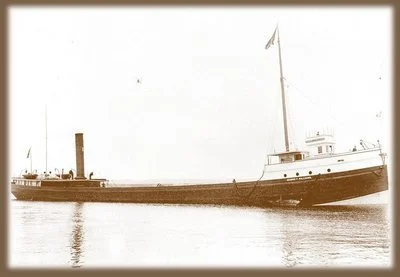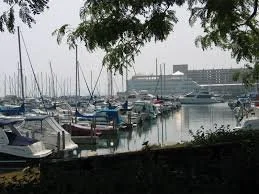An Early Discovery in Whiting: The George F. Williams Shipwreck
Anthony Borgo October 2025
Did you know that there is a shipwreck located within the Hammond marina?
In the Summer of 1981 Tim Early and some of his scuba diving friends heard that you could discover shipwrecks from the air. So, they boarded a four-seater airplane and began to scan the southern shore of Lake Michigan. Early quickly spotted what appeared to be an outline of a wreck just off the shore of Hammond. The friends immediately went diving after returning to land, but only discovered a pile of rocks.
It wouldn’t be for another two years until Tim Early spotted the remains of a shipwreck, 20 feet below the surface. According to a 2001 Reader article, “Swimming straight out from shore, I knew I was bound to hit the target. I came upon a massive wooden ‘wall’ that I thought was a ship, but I couldn’t be sure. Then I began to swim along the side, and swim, and swim, and swim. It was gigantic, like being on an ocean liner in a dense fog.”
Tim Early pictured in the middle
By the time Early received the end of the vessel he was confronted by a massive propeller. Each blade consisted of over six feet in length. , “It was not only a ship, it was one of the largest ships that I had ever been diving on.”
Tim Early grew up on Chicago’s far southeast side. After graduating from high school he took a job at a local factory, then in 1968 found himself in Vietnam where he served as a medic. Growing up Early absolutely loved being in the water. So, after returning to the states he became a certified scuba diver and began working as an scuba instructor. On weekends he would explore Lake Michigan in hopes of finding artifacts or even the elusive shipwreck.
Early was astounded that for so many years the ship had been lying off the city of Hammond and nobody knew anything about it. The shipwreck soon became his obsession, and with the help of other divers they began to survey the remains. The ship sat upright. In addition, the hull, propeller, and boiler were still intact and were covered with algae and zebra mussels. Unfortunately, everything on the upper decks was completely gone. Nothing was left to identify the ship.
In 1988 Hammond city officials announced their intentions to build a marina near the wreckage. Early feared that the construction project would ruin the ship’s remains. He promptly established the Hammond Shipwreck Project, enlisting over 100 volunteers to save the ship by discovering the history of the wreck and publicizing the efforts.
The plan worked. Al Konieczka, who worked for the Encyclopedia Britannica, read about Early’s efforts and wanted to help. He went to the National Archives office located on South Pulaski, where they kept ship records. After scouring through five musty boxes, he came upon sketches of the ship and an inspection report dated April 22, 1915. The George F. Williams had been rediscovered. Konieczka would continue to shed light on the ship’s origin when he visited the Institute for Great Lakes Research in Ohio.
The George F. Williams was constructed in 1889 in Bay City, Michigan for a Cleveland based company called Hawgood. The ship was a 280-foot cross between a sailing ship and a steamer. The hull was made of both wood and steel. The George F. Williams had an engine in addition to four masts, although three of the masts were removed in 1893 to make the ship faster. “It was one of the largest steamers on the Great Lakes, hauling coal with a crew of 20.”
In 1901 The George F. Williams was acquired by the Gilchrist Transportation Company. The Gilchrist Transportation Company located in Toledo once had the largest independent fleets on the Great Lakes. By 1910 Gilchrist was sinking under debt and began auctioning off its ships at fire-sale prices.
Unfortunately, no one bought the George F. Williams, which was towed to Chicago and sold to a salvager named Sam Opinski for $800. Opinski then had it towed to Hammond, where he stripped off the last remaining mast, the engine, and anything else that had value. He then tied the George F. Williams to a pier and abandoned it.
Thomas McDermott
According to the report Konieczka found, “Mr. Opinski was notified that he would be held responsible by the United States in case the wreck should get away and drift out into the Lake.” The tragic fate of the George F. Williams remains shrouded in mystery. One story states that the U.S. The Engineers Office deliberately sank it. Another is that waves from a storm crashed into the vessel causing it to break free from the pier. As it drifted out into the lake, a steel mooring line ripped a giant hole into the bow. As a result water poured in and the ship sank 350 feet from shore.
Tim Early’s efforts were to no avail. City officials announced in 1990 their plans to build a $23 million marina. Early was not discouraged, instead he came up with a new plan to save his shipwreck. He met with Hammond Mayor Thomas McDermott and other city officials. He then got the support of the Indiana Natural Resource Commission. In the end the city of Hammond agreed to move the marina 700 feet to the east preserving the George F. Williams final resting place.
In 2001 Tim Early was diagnosed with lung cancer. Some time later he lost his battle, but not before the Tim Early Foundation was established. In order to keep Early’s dream of educational aquatic programs going the Tim Early Foundation was formed. There is no money taken out of the foundation, 100% goes to their programs.
If you would like to see a video of the George F. Williams click the link below:
SCUBA Diving, George F. Williams Shipwreck, Lake Michigan, 7/4/2014











